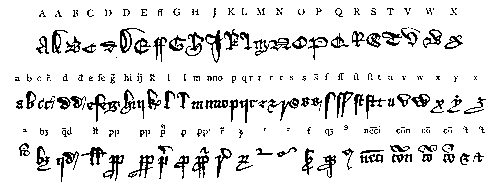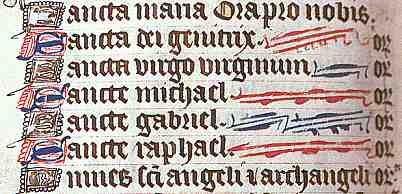



If you are looking at this page without frames, there is more information about medieval writing to be found by going to the home page (framed) or the site map (no frames).
| Tips for Transcribing | ||
| I periodically receive emails from people who have found their way to this website and want to know if I can transcribe and/or translate a document for them, as they are finding the process difficult. The short answer is no, I don't do that on commission, and yes indeed, it is difficult. While I am reluctant to write a simple recipe book on the subject, as everybody thinks a little differently, hopefully here are a few helpful thoughts. | ||
| Some paleography books, and some scholars of my acquaintance, believe in carrying about standard alphabets of letters of particular script styles and comparing their document with them to find the best match. The trouble is that in the real world letter forms are infinitely variable, even if script styles limit their parameters, so it can be hard to find an alphabet that exactly resembles that of any specific document. I have had a number of email writers who have said to me, "I looked at all your script examples and none of them looked quite like my example". The other problem is that letter forms may vary within the one document, especially if the script is cursive. | ||
 |
||
| A sample alphabet, including certain letter combinations, captioned "Bastard Hand: c.1432". (From Jenkinson 1927) | ||
| Scribes for hire in the later medieval and early modern period did use exemplar alphabets, and advertised their skills with lettering books that showed their ability to produce different styles of alphabet for different purposes. | ||
 |
Two different alphabets of small German Gothic book script from the same scribe's display book of 1538. (From Steffens 1929) | |
| Standard alphabets and ones drawn from examples of similar type to your own example will help you to get into the right general headspace, but it pays to work out an individual alphabet for your document, derived from words and phrases that you can recognise, and paying particular attention to those letters which can be tricky, like the vowels and c, r, q, g, s, t and y, and carefully sorting out letters which can be confused. Then when you are reading entire words, ensure that you refer back to your own alphabet, and do not rely on what a word intuitively looks like. That can lead to some horrible and embarrassing misinterpretations. (I have a habit when I am getting tired of thinking I can see words like pizza or modem. Then I know it's time to start spelling out the letters again!) | ||
| If you are transcribing legal documents, such as writs or charters or the like, it pays to look at a number of examples of similar type just to get the standard layout and form of words. This is referred to by paleographers as the diplomatic, but for some reason that term seems to scare people. Basically, it just means that certain types of documents are very formal and repetitive. Certain phrases and expressions are found over and over again, and usually in the same place in the document. For example, in documents from the European continent the date usually appears at the top, while in English documents it more often appears at the bottom. Standard forms of address or introduction are used at the top of the document. This sets up a framework for the reading, and also gives you some known words from which to derive your alphabet. | ||
 |
The opening words of two documents: above a private charter of 1444 in a priovate collection, image ©Rob Schaefer; below a private charter of Richard and Elizabeth Redmayn, of 1417 (British Library, Harleian Charter 112 C 30), by permission of the British Library. | |
| The two examples above begin with the expression Sciant presentes et futuri, which is one of those standard phrases that it just pays to remember. There are many of these in legal documents and getting a handle on some of the most common makes life a lot easier if this is the kind of material you are interested in. | ||
| The examples above also bring up the issue of abbreviation, which is something to be continually aware of. Look for the abbreviation marks in the form of slashes or squiggles above or below the letters. Sometime abbreviation marks can resemble letters, like the suffix -ibz for -ibus or what looks a bit like a g for the prefix con-. Certain kinds of text may also have a their own form of hyperabbreviation for common words or phrases. A legal document my use imppm or inppm for in perpetuum. The litany of the saints in a psalter, breviary or book of hours may use or for the repeated expression ora pro nobis . | ||
 |
Section of the litany from a 15th century book of hours (National Library of Australia, MS 1097/9, f.53r, by permission of the National Library of Australia. | |
|
|
||
|
|
||
|
If you are looking at this page without frames, there is more information about medieval writing to be found by going to the home page (framed) or the site map (no frames). |
||